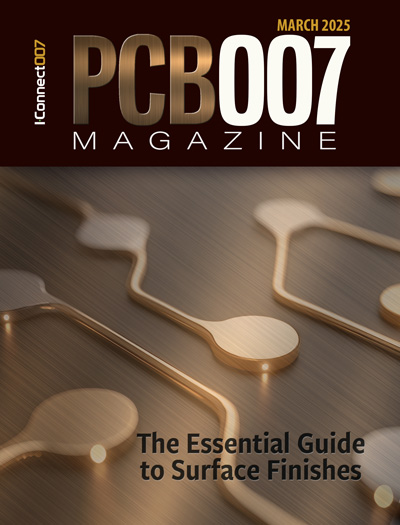-

- News
- Books
Featured Books
- pcb007 Magazine
Latest Issues
Current Issue
In Pursuit of Perfection: Defect Reduction
For bare PCB board fabrication, defect reduction is a critical aspect of a company's bottom line profitability. In this issue, we examine how imaging, etching, and plating processes can provide information and insight into reducing defects and increasing yields.

Voices of the Industry
We take the pulse of the PCB industry by sharing insights from leading fabricators and suppliers in this month's issue. We've gathered their thoughts on the new U.S. administration, spending, the war in Ukraine, and their most pressing needs. It’s an eye-opening and enlightening look behind the curtain.

The Essential Guide to Surface Finishes
We go back to basics this month with a recount of a little history, and look forward to addressing the many challenges that high density, high frequency, adhesion, SI, and corrosion concerns for harsh environments bring to the fore. We compare and contrast surface finishes by type and application, take a hard look at the many iterations of gold plating, and address palladium as a surface finish.
- Articles
- Columns
Search Console
- Links
- Media kit
||| MENU - pcb007 Magazine
Happy Holden Book Excerpt: CIM & Automation Strategy
May 22, 2020 | Happy Holden, I-Connect007Estimated reading time: 2 minutes
The following is an excerpt from Chapter 1 of Happy Holden’s I-Connect007 eBook Automation and Advanced Procedures in PCB Fabrication. In this book, Happy explains fabrication automation with illustrative examples and anecdotes from his decades as a mechanization leader.
Chapter 1: CIM & Automation Strategy
There's a lot of talk about automation, but I find that there is very little available on automation planning. This is one of my specialties. I started by studying for an MSEE in control theory. This went well with my bachelor’s degree in chemical engineering, because I specialized in process control and IC manufacturing.
This led me to take my first job at Hewlett-Packard. They wanted to automate their IC production line, even back in 1970. I discovered there were many companies offering equipment and software, but few had a strategy for how to automate. So we developed a methodology that has worked for very well over the years. In the next chapter, I will focus on computer-aided manufacturing and the connectivity issues with different protocols and available software.
Remember, the benefits will be derived only if certain cardinal principles are observed. This chapter briefly outlines the background of computer-integrated manufacturing (CIM) and six automation principles: superiority, simplicity, flexibility, compatibility, manufacturability, and reliability.
Introduction
The characteristics of successful automation application in manufacturing depend on how well business and technical management understand and promote the strategies, tactics, and philosophies used in modern manufacturing. Successful automation implementation can be enhanced in any company, small or large, by reviewing philosophies of CIM, automation, managements roles, mechanization, SPC, TQC, Lean, MRP and design for manufacturing.
Computer-Integrated Manufacturing (CIM)
The strategies outlined here are considered CIM, which HP was once in the business of selling. HP called it “The Manufacturers Productivity Network,” or MPN. These products included various software, computer, networking, interface, and measurement systems.
At that time, HP had been in the business longer than any other company. It started with government and other requests for automated test and measurement systems. Because of the need to automate various measurement instruments and systems, HP created the first machine-to-machine protocol called HP Interface Bus (HP-IB). This was later formulized into the IEEE-488 Communication Standard.
HP needed an instrument controller, so they purchased a unique 16-bit computer architecture from Union Carbide, which became the HP2116A in 1964. This computer was unique because the operating system was real-time, interrupt-driven, and had space for 16 interface cards for measurement instruments. What HP did not realize was that many companies were using the computer not with instruments, but with multiple input terminals and printers, creating the first time-share systems. Thus, HP created a smaller and lower-cost version called the HP2114A. This led to the world’s first time-share system, the HP2000.
To download Happy's free eBook from the I-Connect007 library, click here, or to order your print-on-demand copy, click here.
Check out all of the free eBooks in the I-Connect007 Library, covering PCB design, fabrication, assembly, and much more.
Suggested Items
IPC Launches New Wire Harness Design Course Led by Defense Industry Expert
06/03/2025 | I-Connect007 Editorial TeamIPC is expanding its educational offerings with a new online course designed to provide foundational knowledge in wire harness and cable design. The course, Introduction to Wire Harness Design I, is led by a seasoned mechanical engineer and subject matter expert in military cable systems working at FNSS Defense Systems in Turkey.
Cicor Closes Strategic Partnership with Mercury and Strengthens Market Leadership in the European Defense Sector
06/03/2025 | CicorCicor Group announces today the successful completion of the strategic supply partnership with Mercury Mission Systems International S.A. (Mercury) announced in April.
Mycronic’s Global Technologies Acquires Surfx in the US
06/03/2025 | MycronicMycronic’s Global Technologies division has acquired Surfx Technologies, a company headquartered in the US, providing atmospheric plasma solutions for surface treatment, including cleaning and active oxide removal.
Quasar Medical to Acquire Nordson MEDICAL Design and Development business in Galway, Ireland and Tecate, Mexico
06/02/2025 | Quasar MedicalQuasar Medical, a global leader in the manufacturing of interventional and complex minimally invasive devices, announced it has signed a definitive agreement with Nordson Corporation to acquire its design and development contract manufacturing businesses in Galway, Ireland, and Tecate, Mexico.
Global Smart Manufacturing Market Size to Reach $787.54 Billion by 2030
06/02/2025 | PRNewswireThe global Smart Manufacturing Market Size is projected to be valued at USD 297.20 billion in 2023 and reach $787.54 billion by 2030, growing at a CAGR of 14.9% according to a new report by The Research Insights.


